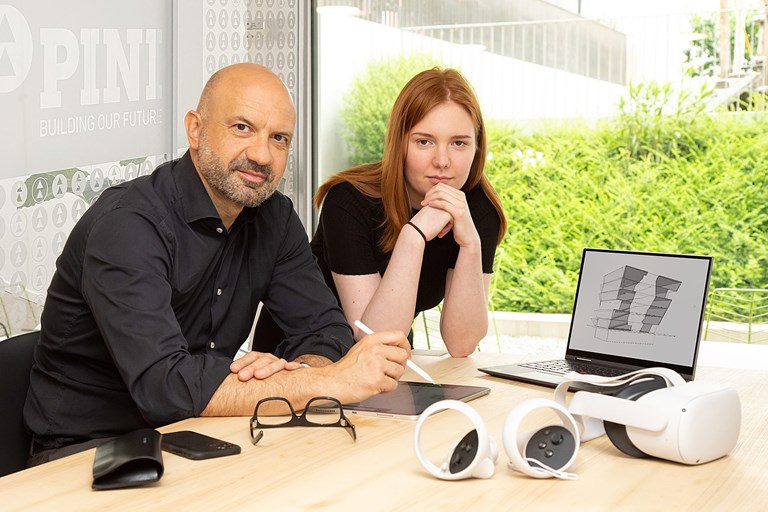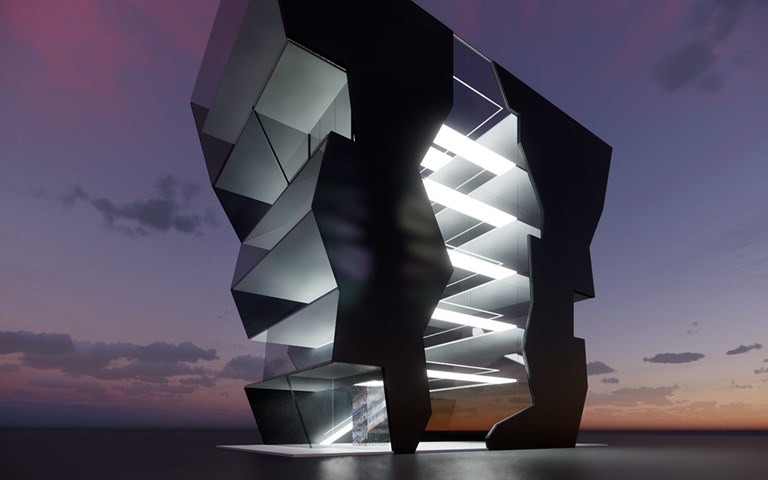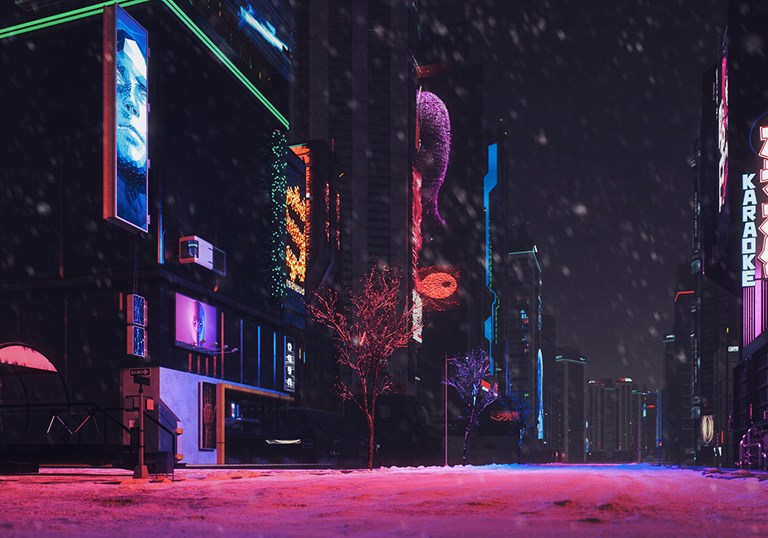
The architects in metaverses
If we had to make an urban planning comparison, we can think of American cities that have sprung up from nothing, or of Dubai, where the buildings have an essentially attractive character
What are metaverses?
We have heard about them on TV, read the headlines, commented on the tweets and shared the posts. Few of us, however, have had direct experience. For most people, the word ‘metaverse’ evokes an aesthetic somewhere between the world of video games, science fiction films and cyberpunk culture.
Yet the metaverse will shape society and the economy in the near future. According to a recent report by Citigroup, the New York banking giant, the ‘metaverse economy’ could be worth up to 13 trillion dollars by 2030.
The easiest way to explain what a metaverse is to imagine it as a city. A place where you move around, form relationships, enter clubs, window shop, study, do business and listen to concerts. The difference is that we dress with an avatar (a digital character that we want to represent us) and the look is not a function of the weather but of how we want to show ourselves. In the metaverse, there are those who just take a tour (the guests), those who have credits to make purchases (there are blockchain-based and cryptocurrencies) and those who, finally, own a plot of virtual space. The plots are limited and there are rules on how and what can be built on them. That is why these worlds, founded mainly by groups of programmers from the world of games and inspired by an ideology based on decentralisation, need architects. They need them to be not only places of fantasy, but also spaces that can be lived in and inhabited by millions of people.
Umberto Ceccarelli and Kateryna Chaplynska work for Pini Group to design in the metaverse and tell us about their experience.
What is the difference of designing and building in the metaverse compared to other virtual worlds?
Ceccarelli: “They are an interactive social-economic and cultural space that persists even when users leave the programme. Each metaverse is unique and autonomous in its constitution. The virtual inhabitants themselves collaborate in its cogeneration and thus create new and innovative social dynamics of the built environment. Compared to social networks, the big difference is this: being founded on a structure based on blockchain technology, so each metaverse cannot be duplicated and what happens in it cannot be deleted, in the sense that a trace of the operations we perform remains.”
Are we talking about a finite world?
Ceccarelli: “Not in all metaverse the number of plots is finite, only in the main ones where the real estate market is developing, for example Decentraland. In general, we are dealing with NFT objects, unique objects that cannot be replicated.”
What do the cities of the metaverse resemble?
Ceccarelli: “If we had to make an urban planning comparison, we can think of American cities that have sprung up from nothing, or of Dubai, where the buildings have an essentially attractive character and where the formal aspect wins out over social and cultural interaction. In these cases, a designer, an architect by training, can make a difference to the vision that game designers have. In video games, the experience to invest in is to push the user/player to capture and not to be captured, to have a mission to fulfil.”
So what is the element that metaverse founders usually do not take into account when designing?
Ceccarelli: “The big challenge is to offer the duration of the experience. In the metaverse you move very fast, you find it hard to stop, it’s as if when faced with a new world you want to explore as much as possible. In the real world, on the other hand, we are dealing with places designed for the duration of relationships, to facilitate encounters, just think of squares, parks. The metaverse is not a virtual reality in which I enter, look and leave. Instead, it is based on interaction: from education to business, but also in terms of artistic and cultural exchanges. For example, there are universities that hold lectures. Therefore, it is necessary to understand these dynamics and design places that offer pleasant experiences, that invite people to come back. They must not only have the ‘wow’ effect, the effect of surprise.”
What constraints are there in the design?
Ceccarelli: “As I said, first of all, you have in most cases a limited space, a parcel of land and where there is limited property, of course there is speculation. Since October 2021, land prices have risen dozens of times. Depending on the location, there are plots of land worth a million Francs.”
Chaplynska: “The presence of planning restrictions is very interesting and challenging. For example, elements called polygons are used to build. Each polygon has its own cost, so it is a challenge to be able to build beautiful and functional things using only a certain number of polygons. It is a bit like in the real world with raw materials.”
What changes from a structural point of view?
Chaplynska: “In most cases you start with the rules of reality, you almost always find doors and other architectural elements that invite you in. Then there are those who have less architectural culture and turn buildings into a kind of sensational chamber of wonders. For example, a roof does not serve its function. There is nothing that risks getting wet. But there is a tendency to replicate environments that have familiar elements.”
What are the most interesting metaverses?
Ceccarelli: “In Switzerland today, investments are mainly in Decentraland, The Sandbox and Cryptovoxels. For instance, some of the big names have already invested in them, replicating their locations. Anyone with a minimum of computer skills can create a metaverse; dozens of them are born every day. We cannot know today who will establish and last. There will be a selection as there was with the internet in its early days. Probably the real boom will come when Meta, the Facebook company, launches its Horizon Worlds metaverse on a large scale. When it becomes an experience that you can access from your smartphone, everyone will want to enter.
Many associate the metaverse with virtual reality, is that so?
Ceccarelli: “The metaverse is a form of virtual reality. But if by virtual reality we mean the immersive experience one has with a visor such as Oculus, it should be pointed out that all metaverses are primarily usable from web platforms, hence from any laptop. Indeed, the blockchain technology that underpins metaverse does not always interface easily with the technology used by virtual reality viewers. Many think of films like ‘Ready Player One’, with a hyper-connected humanity, living in a reality of degraded suburbs and spending time with a visor over their eyes in a virtual world with their avatar. It is an idea of the metaverse that can generate resistance when it comes to investing or designing in the metaverse. Today, metaverses are instead something else, they are opportunities to interact with real content. For example, a way to do professional training even with very large teams.”
What are you currently doing in the metaverse?
Ceccarelli: “We partner with a company that specialises in scouting, i.e. finding land in the metaverse, and implementing the software. We offer the architectural design part. In addition to building the headquarters of the Pini and Galli groups, we are following projects in the field of sport and the creation of an art gallery.”
What do art galleries sell in the metaverse?
Chaplynska: “They sell NFT (non-fungible token, ed) works. This blockchain-based system guarantees the ownership and authenticity of an asset.”
How are art galleries structured?
Chaplynska: “Like a real exhibition space, the aim is to have well-lit spaces, to provide an experience of liveability and of the pleasure of encounters.”
Are sellers real or virtual?
Ceccarelli: “Currently in the metaverse it works more or less like in non-virtual reality, if you want to meet people to do business you make an appointment or attend a scheduled event. Or there are opening hours. The difference to the physical world is that you meet between avatars.”
No handshake
Ceccarelli: “In the multiverse we take on the appearance of cartoon-like characters, who can also be super-accessorised and with these skins, i.e. clothing, we also meet for professional reasons. Undoubtedly, one of the factors to be evaluated will be how this ludicisation of experience and encounter with others will influence socio-economic relations.”
Main metaverses
Decentraland
Founded in 2017, the company launched its Metaverse platform to the public in 2020. Users can create content, interact with each other and earn money, mainly through investments in non-fungible tokens, VR real estate and other digital assets. The platform is fully decentralised and operates via its own cryptocurrency called Mana registered on the Ethereum blockchain. It is a favourite among large investors, corporations and governments.
The Sandbox
Sandbox is a gaming environment where users can create games, participate in events, navigate VR worlds using maps and purchase land, similar to Decentraland. Its cryptocurrency token called SAND. Lands can be rented for events whose participation requires an admission fee, or merged to create a district to attract more paying users.
Cryptovoxels
Cryptovoxels is a Metaverse platform built on Ethereum’s blockchain protocol. It is compatible with Oculus Quest, Oculus Rift and HTC Vive VR support.
Origin City is an ‘island’ where you can interact with other avatars and the plots of land on which you can build are called ‘parcels’. By means of the ‘voxel’ building element, shops, buildings, infrastructure can be erected.
Somnium Space
Somnium Space was in fact the first metaverse to enable a built in experience that can already be experienced with VR viewers. It works on the Ethereum Blockchain and has its own native cryptocurrency The Somnium Space Cubes (CUBE).
Umberto Ceccarelli
Year of birth: 1972
Profession: architect
After graduating in Architecture from the University of Venice, he worked on building design in a number of studios in Milan. For the past 13 years, he has been working in Switzerland, and at Pini he has been particularly involved in Bim and 3D design. Today he holds the position of Virtual Design and Construction Manager.
Kateryna Chaplynska
Year of birth: 1997
Profession: architect
Graduated in Architecture in Kiev, after an experience in a medium-sized company in Ukraine, since March 2022 she has been in Switzerland and is employed at Pini working on design in the metaverse.

Playlist



